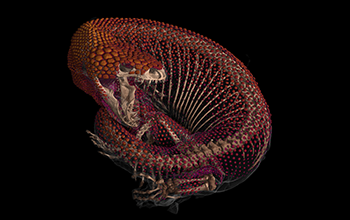Multimedia Gallery
CT scan of Mexican beaded lizard (Heloderma horridum) covered in bony armor studs
A computed tomography scan of a Mexican beaded lizard (Heloderma horridum) covered in bony armor studs. This scan, one of over 15,000 digitized scans created for the openVertabrate (oVert) project, will help scientists track the evolution of similar armor plating in a wide range of fish, amphibians, reptiles and even mammals.
[Research supported by U.S. National Science Foundation grants DBI 1700908, DBI 1701402, DBI 1701516, DBI 1701665, DBI 1701713, DBI 1701714, DBI 1701737, DBI 1701769, DBI 1701797, DBI 1701870, DBI 1701932, DBI 1701943, DBI 1702143, DBI 1702263, DBI 1702421, DBI 1702442, DBI 1802491, DBI 1902105, DBI 1902242, DBI 2001435, DBI 2001443, DBI 2001474, DBI 2001652, DBI 2101909 and RCN 2226185.]
Learn more in the Florida Museum of Natural History news story Scientists CT scanned thousands of natural history specimens, which you can access for free. Or visit the oVert website. (Date of image: Uknown; date originally posted to NSF Multimedia Gallery: May 31, 2024)
Credit: Edward Stanley/2019 Florida Museum
Images and other media in the National Science Foundation Multimedia Gallery are available for use in print and electronic material by NSF employees, members of the media, university staff, teachers and the general public. All media in the gallery are intended for personal, educational and nonprofit/non-commercial use only.
Images credited to the National Science Foundation, a federal agency, are in the public domain. The images were created by employees of the United States Government as part of their official duties or prepared by contractors as "works for hire" for NSF. You may freely use NSF-credited images and, at your discretion, credit NSF with a "Courtesy: National Science Foundation" notation.
Additional information about general usage can be found in Conditions.
Also Available:
Download the high-resolution JPG version of the image. (876.6 KB)
Use your mouse to right-click (Mac users may need to Ctrl-click) the link above and choose the option that will save the file or target to your computer.

 All images in this series
All images in this series